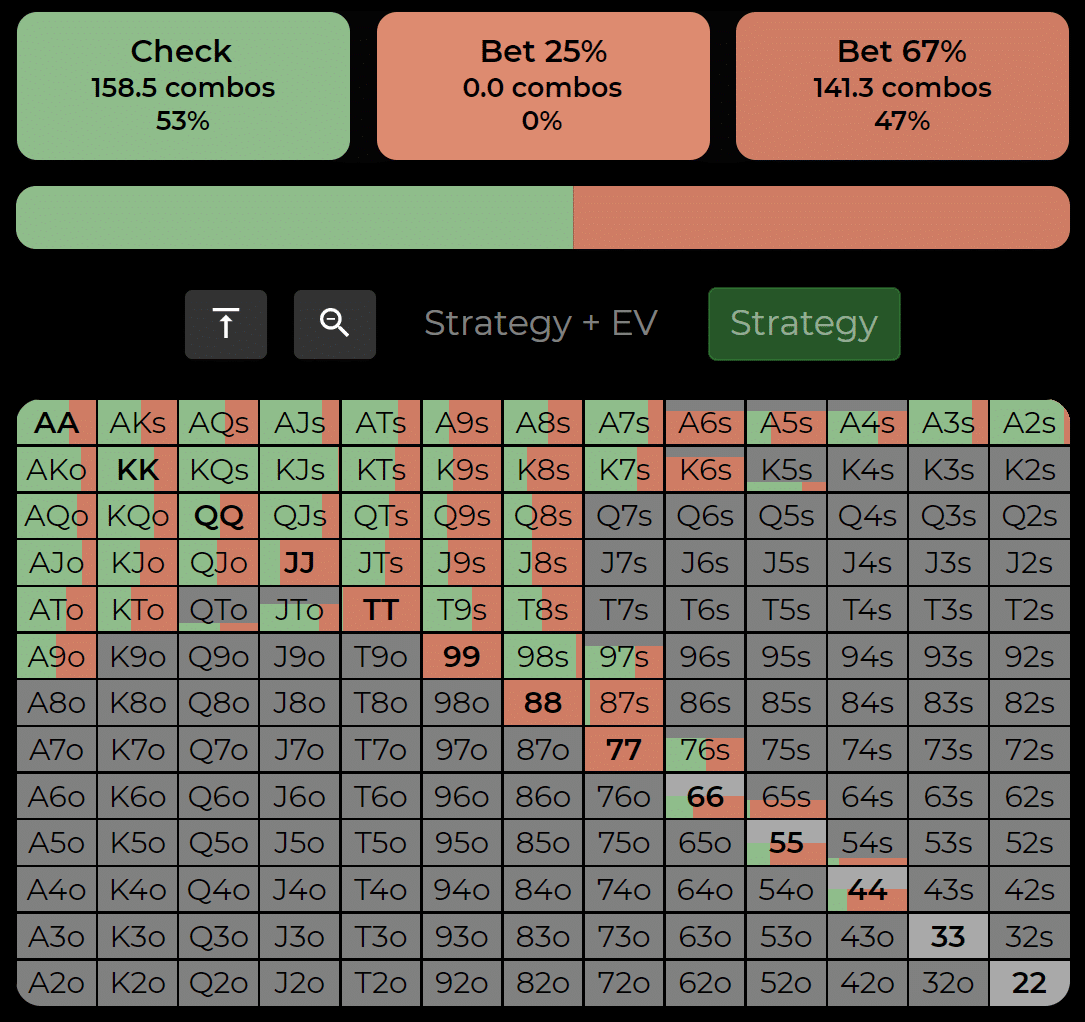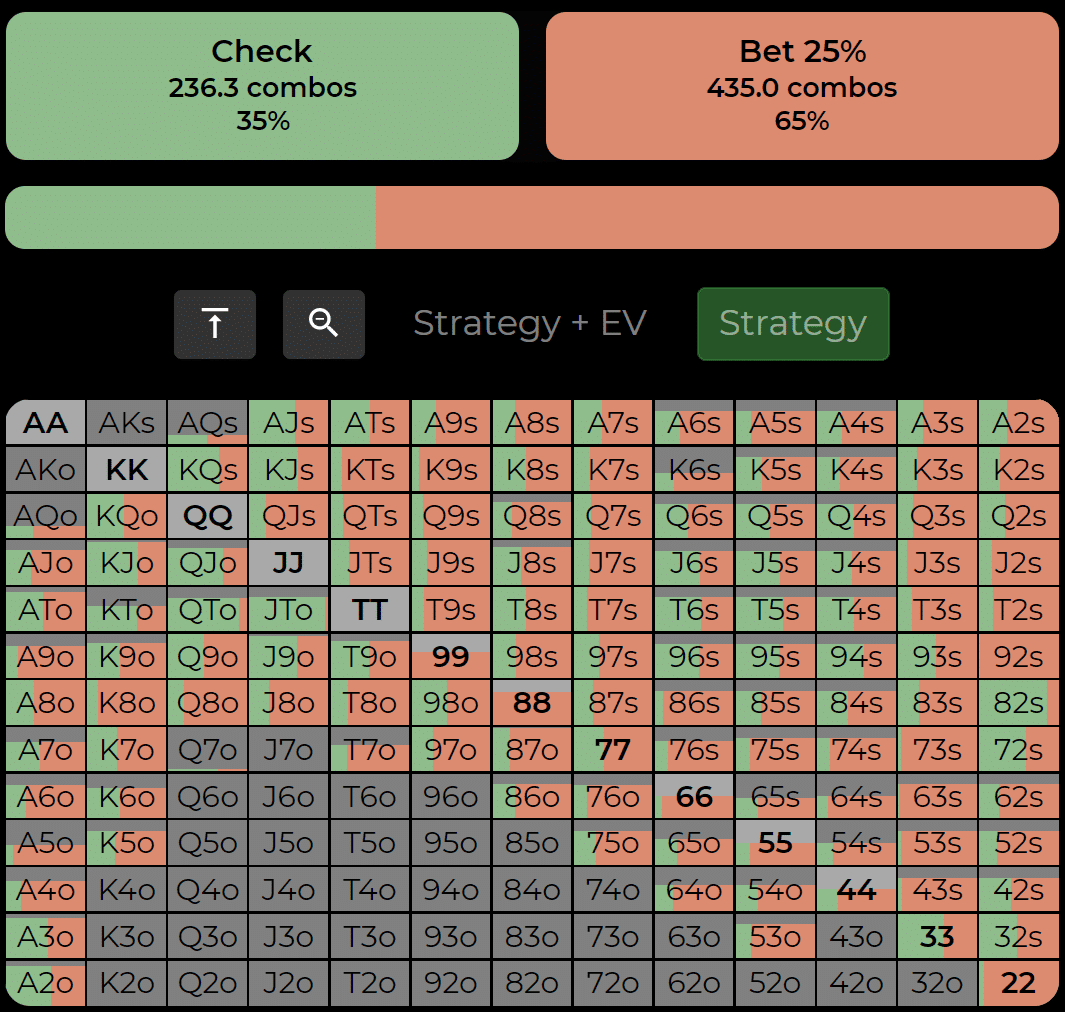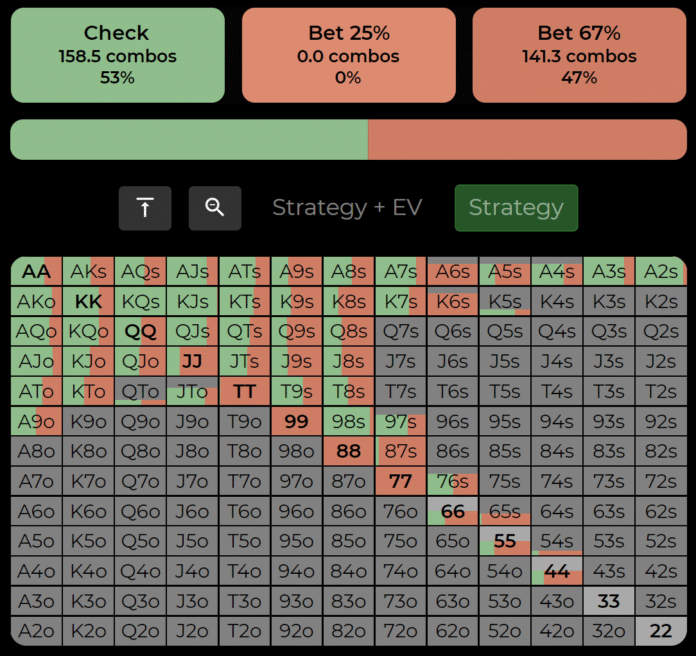Let’s face it.
Checking again stinks, doesn’t it?
It might probably really feel even worse than folding — probably the most cowardly act in poker.
Not less than while you check-fold, you by no means had the betting result in start with.
Right here, although? You talked an enormous sport along with your open-raise, solely to start out backpedaling as soon as the flop hits.
You look at your opponent, a stone-faced Scandinavian. You look down on the 7d 7c 6c flop. Then you definitely look again at your As Td.
You don’t wish to guess for concern of a check-raise.
You don’t wish to test for concern of a flip lead.
“What would Phil Hellmuth do?” you ask your self. “He’s the GOAT… me? I’m only a bum.”
In at present’s article, I’ll provide the instruments to deal with uncomfortable boards because the preflop raiser.
What you gained’t be taught right here is methods to silence unfavourable self-talk or construct the internal resilience wanted to crush poker on the highest ranges — that’s a job in your therapist.
However in relation to fairness disadvantages? This text has you lined.
Right here we go.
The Fundamentals of C-Betting
Earlier than you’ll be able to perceive when to test again the flop, you want a agency grasp on continuation betting.
A very long time in the past, earlier than the age of solvers, c-betting rose to reputation for one easy motive: it labored. Some sharp minds of that period had already discovered why it labored, however most gamers believed it succeeded as a result of the preflop raiser had the “betting lead.” Ideas like “enjoying in stream” unfold by the poker world, with the concept being that whoever began telling the story obtained to maintain telling it.
Immediately, solver outputs affirm what these early gamers sensed. Their logic was crude and incomplete, however the fundamentals have been surprisingly near the mark.
The Essential Drivers of C-Betting
(Trace: It’s not betting lead)
If c-betting have been solely about sustaining the betting lead, you’d by no means test again. The truth that solvers do test again proves that whereas “betting lead” may be tactically purposeful, it isn’t the true driver.
C-bet frequencies hinge on two issues:
-
Vary Benefit — whose vary has extra general fairness.
-
Instance: Button opens, Massive Blind calls. On Ks 7c 3d, the Button holds extra robust palms (greatest Kx, AA, prime set), whereas the Massive Blind has many weaker palms (small pairs, suited connectors, and so forth.). General, the Button’s vary fairness is increased — that is vary benefit.
Importantly, “robust” is outlined by board texture. So it’s not simply vary benefit that issues, but additionally nut benefit.
-
-
Nut Benefit — whose vary has extra of absolutely the strongest palms.
-
Instance: On 8d 7d 6d, the Massive Blind (caller) has much more flushes and straights, whereas the Button (raiser) has comparatively few. Even when the Button owns a slight vary fairness edge, the Massive Blind controls the nutted palms most frequently.
-
Sure, you might have extra overpairs and prime pairs in your vary, however keep in mind: No-Restrict Maintain’em is a five-card sport.
Notice: For some readers this will really feel primary, however it’s important groundwork earlier than we dive into the good things. Persist with me.
Checking Again is About Respect
If you happen to adopted the final part carefully, you could already sense the true driver behind check-backs: respect.
Not respect for the individual — although you must respect each opponent, even the so-called villain — however respect for his or her vary.
Respect means recognizing when your opponent’s vary is dense with robust palms and pure high-equity continues. In these instances, you test extra typically. The textures that demand this respect are simple to identify: low, linked boards the place the Massive Blind’s vary interacts closely — assume 6h 5c 4s rainbow, 7d 7s 6d with a flush draw, or 8c 6c 5c monotone.
That stated, this isn’t black and white. Some boards you c-bet virtually each time. Others you test virtually each time.
More often than not, although, the optimum technique lies someplace in between. It’s about frequency.
Now that we’ve cleared the speculation, let’s get into the nitty-gritty with an actual instance.
The 6h 5d 4c Instance
You open from the Lowjack with 40bb. The Massive Blind defends.
The flop rolls out 6h 5d 4c. The Massive Blind checks.
What’s your transfer?

Lucid GTO cEV 40bb, LJ v BB: LJ technique going through BB test on 654 rainbow. LJ checks 53% of their vary and c-bets massive 47% of the time.
Pink: Wager, Inexperienced: Examine.
Right here, the LJ technique mixes their actions, with the predominant one being to test. To grasp what a part of the vary desires to test, first have a look at what the solver desires to guess with.
-
High of Vary: Straights, units, and two-pair combos. Robust sufficient to face a nasty runout or some aggression from the BB. Betting these supplies the framework for every little thing else.
-
Weak Worth: [88]–[JJ]. Palms the place fairness is peaking on the flop and whose future is severely impacted by the runout.
-
Robust Attracts: Palms that may face BB aggression now and profit from enjoying many sorts of runouts however don’t have any showdown. Excessive-equity bluffs.
-
EV-Flooring Unpaired Excessive Playing cards: Right here, palms like [A9o], [KTo], [QTo], and [JTs]. These palms are low EV relative to what’s obtainable in vary, lack playability, and have restricted means to enhance. Their showdown worth can also be extremely delicate to runouts. There are too a lot of them in vary to guess each time, however they’re vital as current and future bluffs for steadiness.
When you see this, growing a check-back vary turns into a bit simpler. It’s apparent to say, however you test again palms that don’t profit from betting. On low boards, the burden of checking again will often fall in your greatest Ax and broadways (those with a backdoor flush draw are good). These don’t wish to bet-fold, and whereas some can stand up to a check-raise, placing your self in a spot the place you might be bet-calling too typically with them can get costly.
To maintain the BB from getting out of line while you test again, the solver mixes in 7x (A7s, K7s, 97s), 98s, and typically units or two pair (76s), together with premium overpairs (AA, KK). Chances are high you already test again palms like AK, KQs, KK, and AA. The adjustment is just so as to add in these attracts and stronger combos.
Enjoying this manner means you continue to have robust palms and potential nuts on future streets when the runout invitations BB aggression. That prints when your opponent makes the error of disrespecting your vary.
Even in concept, respect is a two-way road.
When to Examine Again Greater than GTO
Are you stunned at how excessive the c-bet frequency is on this instance? LJ is meant to fireplace 67% pot 47% of the time.
“I assumed this text was about checking again…”
Main Ranges Impression C-Wager Methods
Within the above output, there’s a slight desire for checking again (53%). That may not seem to be a lot, however it’s due in no small half to the BB’s failure to steer.
Have a look.

Lucid GTO cEV 40bb, LJ v BB: BB technique on 654 rainbow as first to behave.
Pink: Wager, Inexperienced: Examine.
Right here, you’ll be able to see that the BB ought to aggressively lead this board (65% frequency — 435 of their 671 whole combos), leveraging their top-end benefit. They’ve loads of 6x, two pair, units, and straights. They even maintain some overpairs ([88]–[99]). Even their bluffs, like unpaired 7x, carry loads of fairness (for instance, Qh7h price 3.25bb).
As a result of this resolution was set as much as embody main (donk bets), when the BB does test, they’ve fewer of their strongest combos. That’s why the LJ checks much less typically right here than you would possibly in any other case count on.
So what in case your opponents don’t lead?
Take note of them. Are they main boards that favor them, like this one? If that’s the case, replicating a Lucid-style technique will carry out nicely. But when they aren’t — and a few villains won’t ever lead flops from the BB — then though the solverland technique checks again 53% of the time, you’ll be higher off upping your check-back frequency on these boards. You wouldn’t be far off merely checking again more often than not.
Ideas for Exploiting Flop Leads (or the Lack Thereof)
The inclusion or removing of flop leads creates loads of room for errors — and due to this fact, exploitation. If you happen to discover an opponent main low boards, take note of whether or not they’re weighted towards worth or bluffs. Nailing frequencies in these spots is hard, and most gamers will lean too far in a single route.
-
If you happen to play on-line: test your HUD for elevated RFI, c-bet, 3-bet, and flop check-raise stats. In case your opponent tends towards aggression, chances are high their leads are overweighted to bluffs since they gained’t have robust palms typically sufficient to again up their aggression. This lets you slowplay your greatest palms, or 2-bet utilizing a hand-vs-range framework (e.g., they lead on 6h 5d 4c, you 2-bet [A6] for worth/safety, otherwise you rebluff with [K7s], which is forward of their bluffs and nonetheless has fairness versus actual palms).
-
If their stats skew passive: count on the next density of nutted palms. In these instances, get out except you’ve robust methods to enhance or are already nutted your self.
-
If you happen to play reside: you don’t have a HUD, however you do have the benefit of single-tabling and observing each element. Apply the identical logic — and keep in mind, it’s not often excellent news when the OMC instantly decides to steer.
-
In case your opponents aren’t main in any respect: watch out along with your c-bets. Within the above instance, betting 47% with a big dimension can be too frequent. On low, linked boards (9 or beneath), particularly with a flush draw current, you must test again extra typically. In any other case, your opponent retains all of the palms they have been supposed to steer with, which implies they will punish you with higher-frequency check-raises or call-flop, donk-turn strains.
Abstract
Growing check-back methods is definitely fairly easy when you perceive what drives your c-betting. When your opponent has each a spread and nut benefit, you must test extra typically. That is particularly frequent on low, linked board textures the place your vary is heavy on excessive playing cards and the Massive Blind’s vary interacts extra immediately.
When learning solvers in these spots, watch out to not blindly comply with the outputs. If the Massive Blind doesn’t lead on “their” boards, the checking frequency for the preliminary raiser will naturally enhance because the Massive Blind retains all of the palms they need to have led. If the Massive Blind does lead, be sure that your check-back vary consists of extra than simply excessive playing cards and overpairs. Combine in combos that may enhance on future streets.
Good luck.
Wish to discover ways to maximize your MTT wins with postflop aggression? Learn: This Grasping Worth Wager Technique Will Assist You Win Extra Tournaments.

